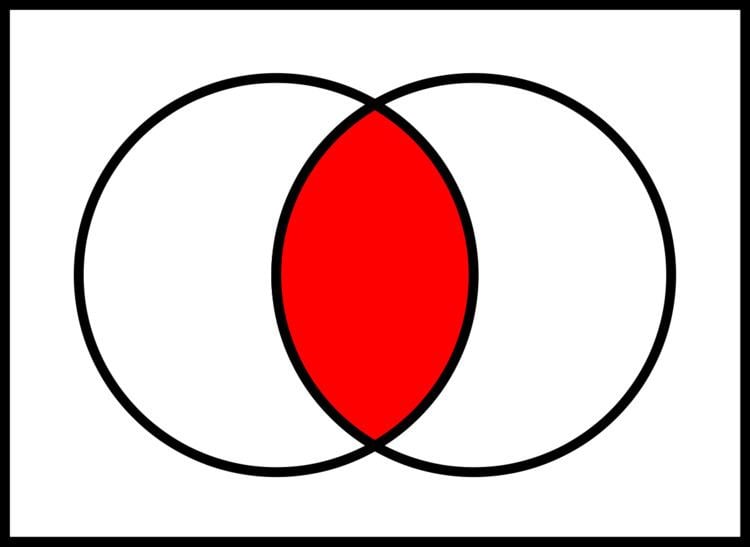 | ||
In mathematics, the intersection A ∩ B of two sets A and B is the set that contains all elements of A that also belong to B (or equivalently, all elements of B that also belong to A), but no other elements.
Contents
For explanation of the symbols used in this article, refer to the table of mathematical symbols.
Basic definition
The intersection of A and B is written "A ∩ B". Formally:
that is
x ∈ A ∩ B if and only ifFor example:
More generally, one can take the intersection of several sets at once. The intersection of A, B, C, and D, for example, is A ∩ B ∩ C ∩ D = A ∩ (B ∩ (C ∩ D)). Intersection is an associative operation; thus, A ∩ (B ∩ C) = (A ∩ B) ∩ C. Additionally, intersection is commutative; thus A ∩ B = B ∩ A.
Inside a universe U one may define the complement Ac of A to be the set of all elements of U not in A. Now the intersection of A and B may be written as the complement of the union of their complements, derived easily from De Morgan's laws:
A ∩ B = (Ac ∪ Bc)c
Intersecting and disjoint sets
We say that A intersects (meets) B at an element x if x belongs to A and B. We say that A intersects (meets) B if A intersects B at some element. A intersects B if their intersection is inhabited.
We say that A and B are disjoint if A does not intersect B. In plain language, they have no elements in common. A and B are disjoint if their intersection is empty, denoted
For example, the sets {1, 2} and {3, 4} are disjoint, the set of even numbers intersects the set of multiples of 3 at 0, 6, 12, 18 and other numbers.
Arbitrary intersections
The most general notion is the intersection of an arbitrary nonempty collection of sets. If M is a nonempty set whose elements are themselves sets, then x is an element of the intersection of M if and only if for every element A of M, x is an element of A. In symbols:
The notation for this last concept can vary considerably. Set theorists will sometimes write "⋂M", while others will instead write "⋂A∈M A". The latter notation can be generalized to "⋂i∈I Ai", which refers to the intersection of the collection {Ai : i ∈ I}. Here I is a nonempty set, and Ai is a set for every i in I.
In the case that the index set I is the set of natural numbers, notation analogous to that of an infinite series may be seen:
When formatting is difficult, this can also be written "A1 ∩ A2 ∩ A3 ∩ ...", even though strictly speaking, A1 ∩ (A2 ∩ (A3 ∩ ... makes no sense. (This last example, an intersection of countably many sets, is actually very common; for an example see the article on σ-algebras.)
Finally, let us note that whenever the symbol "∩" is placed before other symbols instead of between them, it should be of a larger size (⋂).
Nullary intersection
Note that in the previous section we excluded the case where M was the empty set (∅). The reason is as follows: The intersection of the collection M is defined as the set (see set-builder notation)
If M is empty there are no sets A in M, so the question becomes "which x's satisfy the stated condition?" The answer seems to be every possible x. When M is empty the condition given above is an example of a vacuous truth. So the intersection of the empty family should be the universal set (the identity element for the operation of intersection)
Unfortunately, according to standard (ZFC) set theory, the universal set does not exist. A fix for this problem can be found if we note that the intersection over a set of sets is always a subset of the union over that set of sets. This can symbolically be written as
Therefore, we can modify the definition slightly to
Now if M is empty there is no problem. The intersection is the empty set, because the union over the empty set is the empty set. In fact, this is the operation that we would have defined in the first place if we were defining the set in ZFC, as except for the operations defined by the axioms (the power set of a set, for instance), every set must be defined as the subset of some other set or by replacement.
